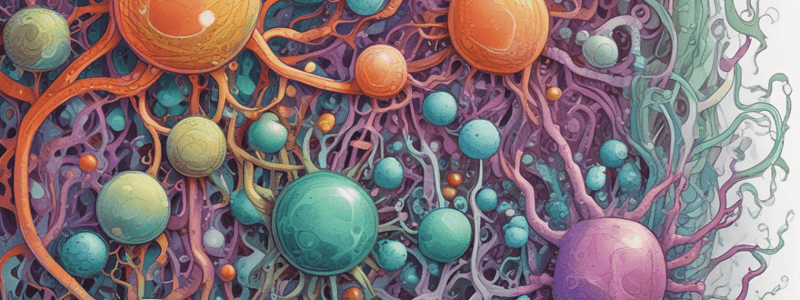Podcast
Questions and Answers
What is the characteristic of the cell wall of gram-positive bacteria that allows them to retain the crystal violet stain?
What is the characteristic of the cell wall of gram-positive bacteria that allows them to retain the crystal violet stain?
- Presence of lipopolysaccharides
- Absence of peptidoglycan
- Thick layer of peptidoglycan (correct)
- Thin layer of peptidoglycan
What is the main component of the cell wall of acid-fast bacteria that makes them resistant to decolorization?
What is the main component of the cell wall of acid-fast bacteria that makes them resistant to decolorization?
- Mycolic acid (correct)
- Lipopolysaccharides
- Sterols
- Pseudopeptidoglycan
Which type of bacteria lacks a cell wall entirely?
Which type of bacteria lacks a cell wall entirely?
- Gram-positive bacteria
- Acid-fast bacteria
- Gram-negative bacteria
- Mycoplasmas (correct)
What is the characteristic of the cell wall of archaea?
What is the characteristic of the cell wall of archaea?
What is the function of sterols in the cell membrane of mycoplasmas?
What is the function of sterols in the cell membrane of mycoplasmas?
Which type of bacteria has a cell wall that is most similar to the cell walls of archaea?
Which type of bacteria has a cell wall that is most similar to the cell walls of archaea?
What is the primary function of lipopolysaccharides in the outer membrane of gram-negative bacteria?
What is the primary function of lipopolysaccharides in the outer membrane of gram-negative bacteria?
Which type of bacteria is most likely to be affected by the decolorization step in acid-fast staining?
Which type of bacteria is most likely to be affected by the decolorization step in acid-fast staining?
What is the primary component of the cell wall of gram-positive bacteria that allows it to retain the crystal violet stain?
What is the primary component of the cell wall of gram-positive bacteria that allows it to retain the crystal violet stain?
Which type of bacteria is likely to have a cell membrane that is more resistant to osmotic stress?
Which type of bacteria is likely to have a cell membrane that is more resistant to osmotic stress?
Flashcards are hidden until you start studying
Study Notes
Cell Walls of Different Bacteria and Microorganisms
- Gram-positive bacteria have a thick layer of peptidoglycan in their cell wall, which retains the crystal violet stain used in the Gram stain procedure.
Characteristics of Cell Walls
- Gram-negative bacteria have a thinner peptidoglycan layer and an outer membrane containing lipopolysaccharides (LPS), which does not retain the crystal violet stain but takes up the counterstain (safranin).
- Acid-fast bacteria have a waxy lipid (mycolic acid) in their cell wall, which makes them resistant to the decolorization step in acid-fast staining.
Unique Cell Walls
- Archaea lack peptidoglycan in their cell walls and instead have pseudopeptidoglycan or other complex polysaccharides.
- Mycoplasmas lack a cell wall entirely and have a cell membrane containing sterols for added strength.
Studying That Suits You
Use AI to generate personalized quizzes and flashcards to suit your learning preferences.




